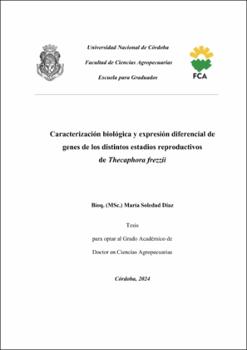| dc.contributor.advisor | Beltramo, Dante Miguel | |
| dc.contributor.author | Diaz, María Soledad | |
| dc.date.accessioned | 2024-04-25T14:34:14Z | |
| dc.date.available | 2024-04-25T14:34:14Z | |
| dc.date.issued | 2024 | |
| dc.identifier.uri | http://hdl.handle.net/11086/551598 | |
| dc.description | Tesis (Doctor en Ciencias Agropecuarias) -- UNC- Facultad de Ciencias Agropecuarias, 2024 | es |
| dc.description.abstract | El cultivo del maní (Arachis hypogaea L.) en Argentina se enfrenta a numerosas
enfermedades fúngicas, siendo el Carbón del maní, causado por el hongo Thecaphora frezzii,
una de las más devastadoras. A pesar de la importancia económica del cultivo en la provincia
de Córdoba, las estrategias de control existentes han demostrado ser ineficaces contra esta
enfermedad. Son escasas las investigaciones previas sobre T. frezzii, por lo que en esta tesis
se propone abordar su estudio desde múltiples perspectivas. Se realizaron ensayos para
obtener todas las estructuras de T. frezzii in vitro, incluyendo basidiosporas e hifas, a partir
de la germinación de teliosporas. Se llevó a cabo una descripción morfológica detallada de
las teliosporas, revelando la presencia novedosa de melanina en sus paredes. Además, se
establecieron técnicas para evaluar la viabilidad de las teliosporas y se exploró la
autofluorescencia como indicador de esta viabilidad. Desde el punto de vista molecular, se
investigaron las modificaciones en la expresión génica y la traducción de transcriptos a
proteínas enzimáticas en diferentes estadios del hongo. Se identificaron proteínas
relacionadas con las modificaciones estructurales durante el ciclo de vida del hongo, así
como factores de virulencia asociados a la patogenicidad. Se analizaron también las
modificaciones bioquímicas presentes en cada etapa de desarrollo, incluyendo los
componentes lipídicos y las enzimas involucradas en su síntesis. Se encontraron derivados
del ergosterol como principales constituyentes de la membrana. Además, se destacaron los
cambios a nivel proteico, con la identificación de bandas proteicas expresadas
diferencialmente entre los estadios de desarrollo, y se profundizó en el estudio de la red
microtubular, centrándose en los cambios postraduccionales de las tubulinas. Este trabajo
proporciona información valiosa para el desarrollo de estrategias de control más efectivas
contra T. frezzii, una enfermedad que sigue representando un desafío para la agricultura local. | es |
| dc.description.abstract | The cultivation of peanuts (Arachis hypogaea L.) in Argentina is challenged by numerous
fungal diseases, among which peanut smut, caused by the fungus Thecaphora frezzii, stands
out as one of the most devastating. Despite the economic significance of peanut farming in
the province of Córdoba, existing control methods have proven ineffective against this
particular disease. Given the limited prior research on T. frezzii, this thesis adopts a multifaceted
approach to its study. Various experiments were conducted to obtain all structures of
T. frezzii in vitro, including basidiospores and hyphae, through the germination of
teliospores. A detailed morphological examination of the teliospores was undertaken,
revealing the novel presence of melanin in their walls. Furthermore, techniques were
developed to assess the viability of teliospores, with autofluorescence explored as an
indicator of viability. From a molecular standpoint, investigations focused on changes in
gene expression and the translation of transcripts into enzymatic proteins across different
stages of the fungus's life cycle. Proteins related to structural modifications during the life
cycle of the fungus were identified, alongside virulence factors associated with its
pathogenicity. Biochemical modifications occurring at each developmental stage were also
analyzed, including lipid components and the enzymes involved in their synthesis.
Ergosterol derivatives were identified as the primary constituents of the membrane.
Additionally, attention was given to changes at the protein level, with differential expression
of protein bands observed between developmental stages. The study of the microtubular
network was also intensified, particularly in relation to post-translational changes of
tubulins. This comprehensive work offers valuable insights for the development of more
effective control strategies against T. frezzii, addressing a significant challenge faced by the
local agricultural sector. | en |
| dc.format.extent | 220 p. : ilustración, fotografías, gráficos, tablas, mapas | |
| dc.language.iso | spa | es |
| dc.rights | Attribution-NonCommercial-NoDerivatives 4.0 International | * |
| dc.rights.uri | http://creativecommons.org/licenses/by-nc-nd/4.0/ | * |
| dc.subject | Maíz | es |
| dc.subject | Enfermedades fungosas | es |
| dc.subject | Hongos patógenos | es |
| dc.subject | Carbones | es |
| dc.subject | Control de enfermedades | es |
| dc.subject | Lípidos | es |
| dc.subject | Proteínas | es |
| dc.subject | Argentina | es |
| dc.title | Caracterización biológica y expresión diferencial de genes de los distintos estadios reproductivos de Thecaphora frezzii | es |
| dc.type | doctoralThesis | es |
| dc.description.fil | Fil: Diaz, María Soledad. Gobierno de la Provincia de Córdoba. Ministerio de Ciencia y Tecnología (MINCyT). Centro de Excelencia en Productos y Procesos (CEPROCOR); Argentina. | es |
| dc.description.fil | Fil: Beltramo, Dante Miguel. Universidad Católica de Córdoba. Facultad de Ciencias Químicas; Argentina. | es |
| dc.description.fil | Fil: Beltramo, Dante Miguel. Gobierno de la Provincia de Córdoba. Ministerio de Ciencia y Tecnología (MINCyT). Centro de Excelencia en Productos y Procesos (CEPROCOR); Argentina. | es |
| dc.description.fil | Fil: Beltramo, Dante Miguel. Consejo Nacional de Investigaciones Científicas y Técnicas (CONICET). Centro Científico Tecnológico (CCT Córdoba); Argentina. | es |





